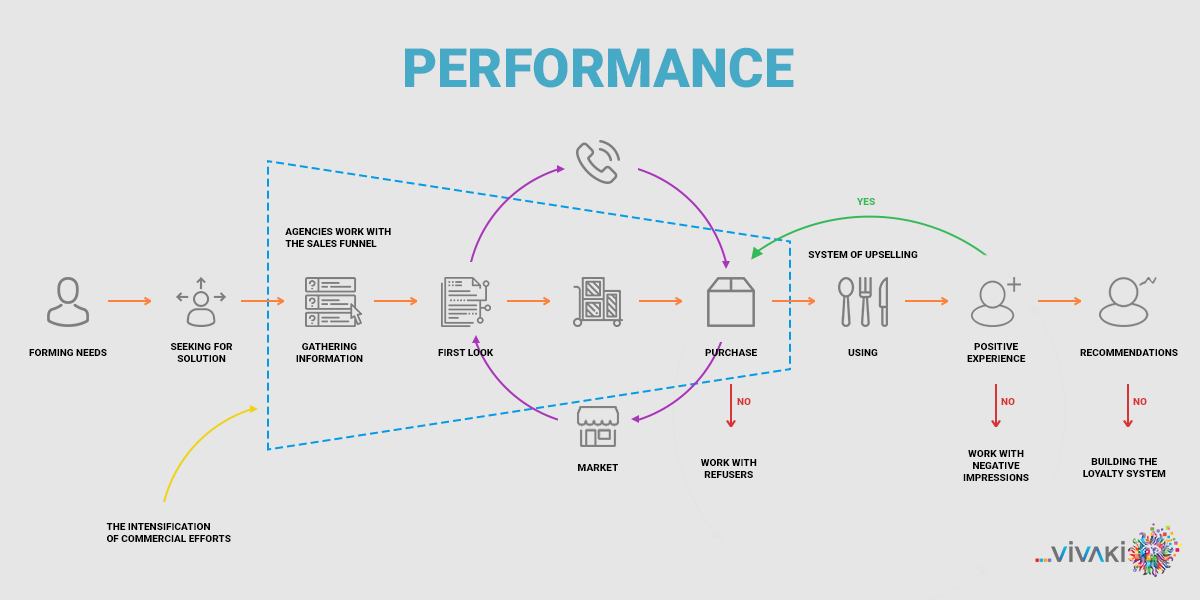
What is performance-marketing and how it works.
What is performance-marketing and how it works.
Most of the agencies, which are working and developing in marketing or media sphere, heard about performance-marketing for a long time. Before we started to write this article we surfed the internet and tried to find more or less exact and clear definition of what performance – marketing is.
So, the website vc.ru says that performance-marketing is a current of advertising in internet that is targeted on maximal transparency between budget of the channel and sales. If income is normal, sales are establishing budget for advertising.
Most of the internet-marketing workers consider that performance- marketing is targeted on the result, that is expressed in growth of sales. This instance can be estimated by the price for a website visitor, price for registration request, final price for a buyer and ROI (Return of Marketing Investment).
Let’s try to return to the reality.
The more we got deeper in investigation of this definition and the more we used tools of performance- marketing, the more we asked ourselves a question – how do you distinguish from others? Because we could measure the efficiency and activity of our users such as place and time when they engage with our content, using web-analytics.
We continued our researches, and created scheme of evolution of clients’ expectations, before they take a decision. So, such as any type of SEO (Search Engine Optimization), performance- marketing passed through the steps of development, and being on the top of development, it began to fall down slowly, requesting optimization. Thus, clients were offered to pay for:
Growth of the traffic;
Placing web-page on the TOP;
Growing of web-page conversion;
Increased return on advertising in the media networks;
A personalised development of the site;
Growth of Brand-recognition;
Growth of the number of leads and calls;
And it worked well before the bound of knowledge of the clients began to expand, or simply they got tired from the same type of offers. Than internet-marketers said loud: “We will make digital advertising work! Moreover, we will ensure analytics of advertising till returning the invests of the company. And you will see how sales in internet will rise guaranteed!” But it is easier to say than to make. A kind of vortex of sales was employed. Well known strategy – step by step logical projecting from appearing of need till taking the decision of buying. For example, agency is offering 1000 visitors, 300 of leads\requests, 100 relevant messages and 20 real sales to lead the client to make partnership.
But in fact, even if offer is subtle, or agency is using hard and unique ways of work, as a result we obtain method that was used by Henry Ford: To make more sales, place more advertise. Nowadays it would sound like: choose a channel, fill the traffic, measure, repeat.
On the one side, this method is clear but often people can’t work through the structure of investigation and control of dates. Here the performance appears and it promises to track and count every click. However, this is not in need. Its target is counting of metrics before beginning of works\sales.
How performance-marketing have to work:

Step 1) Forming need. At this step client may not understand which tools must be used but that there is a problem that have to be resolved. KPI of this step – percentage of the need to grow and expand the sell market in segment.
Step 2) Seeking the solution. The client realized the problem and is beginning to seek the way to resolve it. At this step the client is looking for the best way to do it so we have to grab his attention. KPI of this step is percent of the reach of target audience.
Step 3) Gathering information. Client found the solution and compares your offer with the offer of your competitors. KPI of this step – targeted traffic on singular|one|item of content.
Step 4) First look. Client begins to compare him with his competitors. KPI of this step is publications engagement.
Step 5) Buying cycle. KPI of the step – acquisitions according to the plan, remarketing, actions that stimulate sells.
Step 6) After sell cycle. This period includes user experience that is forming by use of product. Here positive and negative experience appears. KPI of the step – sells during the time, number of positive and negative feedbacks.
Step 7) Recommendations. Clients who came by recommendation is the cheapest audience. The investments that were already made are spent on them. KPI of this step is CRV (customer recommendation value) and saving money for every new client.
We can also say that performance -marketing is multilevel strategy that includes:
- Making the system from discover the real needs till taking decision to buy;
- Complex work on every step: their own banners, landing pages, e-mails, video, scripts etc. ;
- Possibility to measure KPI on every step of the project;
Unfortunately, at the moment everybody understands what it has to be done only on 3rd step.
Today in Moldova there aren’t such agencies who can track metrics before sale. The main work is focused on different points. Performance –marketing means not only to give context and measure requests. Its main task is to construct the whole marketing process and to track it. In performance you have to divide everything in steps to make a good advertising.
Problems of performance – marketing.
Problem 1 – Internet Marketers are making only what they understand. Internet is a part of marketing system. That is why marketers have to work with what they know and also to know well the clients’ business.
Problem 2 – Types of sales. The sales can be:
- Direct\indirect;
- Online\offline;
- By recommendation;
- From the formed need;
- From the unformed need;
- Repeated;
Is important to understand which saless the client wants to increase and to use suitable tools for each of them.
Problem 3 – limited choice of audience. After the ending of showing the advertising in web, agencies can’t compensate decline of sales using organic audience. This is the biggest minus of work with this type of advertising.Problem 4 – Work only with formed need. Most of the agencies don’t have schemes of unformed need. As a result – no recommendations.
Problem 5 – focus on one-time sell. A lot of agencies considering that the work is done after measuring the primary sales. That’s not right because this step is only beginning of a big system.
Problem 6 – Incomplete analyze of sales.
At this point, appears the need of analytical research of the upsales. However, in our country upsales are not analyzed entirely.
